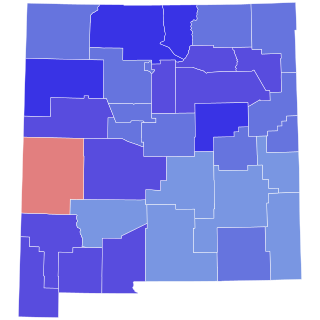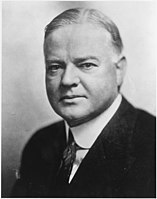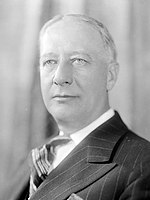
The 2006 New Mexico gubernatorial election was a race for the governor of New Mexico held on November 7, 2006. Incumbent Democratic governor Bill Richardson was running for re-election. He faced Republican John Dendahl in the general election and won by a landslide. As of 2024, this was the last time a male candidate was elected Governor of New Mexico.

The 1928 United States presidential election in Pennsylvania took place on November 6, 1928, as part of the 1928 United States presidential election. Voters chose 38 representatives, or electors to the Electoral College, who voted for president and vice president.

The 1980 United States presidential election in New Mexico took place on November 4, 1980. All 50 states and The District of Columbia, were part of the 1980 United States presidential election. State voters chose four electors to the Electoral College, who voted for president and vice president.

The 1968 United States presidential election in New Mexico took place on November 5, 1968. All fifty states and The District of Columbia, were part of the 1968 United States presidential election. State voters chose four electors to represent them in the Electoral College, who voted for president and vice president.

The 1964 United States presidential election in New Mexico took place on November 3, 1964. All fifty states and The District of Columbia, were part of the 1964 United States presidential election. State voters chose four electors to represent them in the Electoral College, who voted for president and vice president.

The 1952 United States presidential election in New Mexico took place on November 4, 1952. All 48 States were part of the 1952 United States presidential election. State voters chose four electors to represent them in the Electoral College, which voted for President and Vice President.

The 1932 United States presidential election in New Mexico took place on November 8, 1932. All contemporary forty-eight states were part of the 1932 United States presidential election. State voters chose three electors to represent them in the Electoral College, which voted for President and Vice President.

The 1928 United States presidential election in New York took place on November 6, 1928. All contemporary 48 states were part of the 1928 United States presidential election. State voters chose 45 electors to the Electoral College, which selected the president and vice president.

The 1932 United States presidential election in Massachusetts took place on November 8, 1932, as part of the 1932 United States presidential election, which was held throughout all contemporary 48 states. Voters chose 17 representatives, or electors to the Electoral College, who voted for president and vice president.

The 1928 United States presidential election in Massachusetts took place on November 6, 1928, as part of the 1928 United States presidential election, which was held throughout all contemporary 48 states. Voters chose 18 representatives, or electors to the Electoral College, who voted for president and vice president.

The 1928 United States presidential election in Vermont took place on November 6, 1928, as part of the 1928 United States presidential election which was held throughout all contemporary 48 states. Voters chose four representatives, or electors to the Electoral College, who voted for president and vice president.

The 1928 United States presidential election in New Jersey took place on November 6, 1928. All contemporary 48 states were part of the 1928 United States presidential election. Voters chose 14 electors to the Electoral College, which selected the president and vice president.

The 1928 United States presidential election in Rhode Island took place on November 6, 1928, as part of the 1928 United States presidential election which was held throughout all contemporary 48 states. Voters chose five representatives, or electors to the Electoral College, who voted for president and vice president.

The 1928 United States presidential election in Texas took place on November 6, 1928, as part of the 1928 United States presidential election which was held throughout all contemporary forty-eight states. Voters chose 20 representatives, or electors, to the Electoral College, who voted for president and vice president.

The 1936 United States presidential election in Kansas took place on November 3, 1936, as part of 1936 United States presidential election held in all forty-eight contemporary states. Kansas voters chose nine electors, or representatives to the Electoral College, who voted for President and Vice President.

The 1928 United States presidential election in South Dakota took place on November 6, 1928, as part of the 1928 United States presidential election which was held throughout all contemporary 48 states. Voters chose five representatives, or electors to the Electoral College, who voted for president and vice president.

The 1928 United States presidential election in Tennessee took place on November 6, 1928, as part of the 1928 United States presidential election. Tennessee voters chose 12 representatives, or electors, to the Electoral College, who voted for president and vice president.

The 1928 United States presidential election in Oklahoma took place on November 6, 1928, as part of the 1928 United States presidential election which was held throughout all contemporary 48 states. Voters chose ten representatives, or electors to the Electoral College, who voted for president and vice president. In its early years, Oklahoma was a “Solid South” state whose founding fathers like "Alfalfa Bill" Murray and Charles N. Haskell had disfranchised most of its black population via literacy tests and grandfather clauses, the latter of which would be declared unconstitutional in Guinn v. United States. In 1920 this “Solid South” state, nonetheless, joined the Republican landslide of Warren G. Harding, electing a GOP senator and five congressmen, but in 1922 the Democratic Party returned to their typical ascendancy as the state GOP became heatedly divided amongst themselves.

Republican candidate Herbert Hoover won the state of Illinois in the 1928 United States presidential election, and would emerge victorious from the overall election. State voters chose 29 representatives, or electors, to the Electoral College, who voted for president and vice president.

The 1928 United States presidential election in Kentucky took place on November 6, 1928, as part of the 1928 United States presidential election. Voters chose 13 representatives, or electors to the Electoral College, who voted for president and vice president.
























